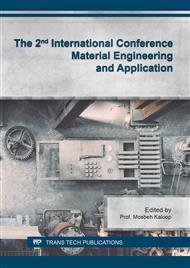[1]
O. B. Hwan, S. Y. Jang, Effects of material and environmental parameters onchloride penetration profiles in concrete structures, Cem. Concr. Res. 37(1) (2007) 47-53.
Google Scholar
[2]
P. K. Mehta, Concrete structure, properties and materials, Ed Prentice-Hall., (1986), pp.105-169.
Google Scholar
[3]
A. Khelidj, A. Loukili, G. Bastian, Experimental study of the hydro-chemicalcoupling inside maturing concretes effect on various types of shrinkage, Mater. Struct. 31(9) (1998) 588-594.
DOI: 10.1007/bf02480608
Google Scholar
[4]
E. P. Nielsen, M. R. Geiker, Chloride diffusion in partially saturated cementitiousmaterial, Cem. Concr. Res. 33(1) (2003) 133-138.
Google Scholar
[5]
C. Arya, S. Bioubakhsh, P. Vassie, Chloride penetration in concretesubject to wet–dry cyclinginfluence of pore structure, Struct. Build. 167(SB6) (2014) 343-354.
DOI: 10.1680/stbu.12.00067
Google Scholar
[6]
K. Hong, R. D. Hooton, Effects of cyclic chloride exposure on penetration of concrete cover, Cem. Concr. Res. 29 (1999) 1379-1386.
DOI: 10.1016/s0008-8846(99)00073-3
Google Scholar
[7]
R. B. Polder, H. A. Willy, Characterization of chloride transport and reinforcement corrosion in concrete under cyclic wetting and drying by electrical resistivity, Cem. Concr. Compos. 24 (2002) 427-435.
DOI: 10.1016/s0958-9465(01)00074-9
Google Scholar
[8]
B. F. Amor, S. Bonnet, A. Khelidj, New approach for coupled chloride/moisture transport in non-saturated concrete with and without slag, Constr. Build. Mater. 35 (2012) 761-771.
DOI: 10.1016/j.conbuildmat.2012.04.106
Google Scholar
[9]
Z. Yu, Y. Chen, P. Liu, Accelerated simulation of chloride ingress into concrete under drying-wetting alternation condition chloride environment, Constr. Build. Mater. 93 (2015) 205-213.
DOI: 10.1016/j.conbuildmat.2015.05.090
Google Scholar
[10]
T. C. Powers, Structures and physical properties of hardened portland cement paste, J. Am. Ceram. Soc. 41 (1958) 5-15.
Google Scholar
[11]
M. Zhang, H. Li, Pore structure and chloride permeability of concrete containing nano-particles for pavement, Constr. Build. Mater. 25 (2011) 608-616.
DOI: 10.1016/j.conbuildmat.2010.07.032
Google Scholar
[12]
N. Neithalath, J. Jain, Relating rapid chloride transport parameters of concretes to microstructural featuresextracted from electrical impedance, Cem. Concr. Res. 40 (2010) 1041-1051.
DOI: 10.1016/j.cemconres.2010.02.016
Google Scholar
[13]
Z. Yu, G. Ye, The pore structure of cement paste blended with fly ash, Constr. Build. Mater. 45 (2013) 30-35.
DOI: 10.1016/j.conbuildmat.2013.04.012
Google Scholar
[14]
R. Loser, B. Lothenbach, An. Leemann, Chloride resistance of concrete and its binding capacity-Comparison betweenexperimental results and thermodynamic modeling, Cem. Concr. Compos. 32 (2010) 34-42.
DOI: 10.1016/j.cemconcomp.2009.08.001
Google Scholar
[15]
S. Tina, S. Pejovnik, G. D. Schutter, Chloride ion penetration into fly ash modified concrete during wetting-drying cycles, Constr. Build. Mater. 93 (2015) 1216-1223.
DOI: 10.1016/j.conbuildmat.2015.04.033
Google Scholar
[16]
J. Liu, F. Xing, B. Dong, Study on water sorptivity of the surface layer of concrete, Mater. Struct. 47 (2014) 1941-(1951).
DOI: 10.1617/s11527-013-0162-x
Google Scholar
[17]
H. Chang, S. Mu, D. Xie, P. Wang, Influence of pore structure and moisture distribution on chloride maximum phenomenon, in surface layer of specimens exposed to cyclic drying-wetting condition, Constr. Build. Mater. 131(1) (2017) 16-30.
DOI: 10.1016/j.conbuildmat.2016.11.071
Google Scholar
[18]
H. Chang, S. Mu, J. Liu, Chloride Distribution Feature in Surface Layer of Cement Paste under Cyclic Drying-Wetting Condition, Key. Eng. Mater. 711 (2016) 367-374.
DOI: 10.4028/www.scientific.net/kem.711.367
Google Scholar
[19]
C. Andrade, M. A. Climent, G. deVera, Procedure for calculating the chloride diffusion coefficient and surface concentration from a profile having a maximum beyond the concrete surface, Mater. Struct. 48 (2015) 863–869.
DOI: 10.1617/s11527-015-0543-4
Google Scholar
[20]
H. Ye, N. Jin, X. Jin, Model of chloride penetration into cracked concrete subject to drying-wetting cycles, Constr. Build. Mater. 36 (2012) 259-269.
DOI: 10.1016/j.conbuildmat.2012.05.027
Google Scholar
[21]
R. A. Cook, K. C. Hover, Mercury porosimetry of hardened cement paste, Cem. Concr. Res. 31(2) (1999) 933-943.
DOI: 10.1016/s0008-8846(99)00083-6
Google Scholar
[22]
H. Pavla, J. D. Rachel, Water permeability and chloride ion diffusion in Portland cement mortars relationship to sand content and critical pore diameter, Cem. Concr. Res. 25(4) (1995) 790-802.
DOI: 10.1016/0008-8846(95)00069-o
Google Scholar
[23]
J. Hu, P. Stroeven, Proper characterisation of pore size distribution in cementitious materials, Key Eng. Mater. 302-303 (2006) 479-85.
DOI: 10.4028/www.scientific.net/kem.302-303.479
Google Scholar
[24]
R. Luo, Y. Cai, C. Wang, Study of chloride binding and diffusion in GGBS concrete, Cem. Concr. Res. 33(1) (2003) 1-7.
Google Scholar
[25]
T. M. Chrisp, W. T. Mccarter, G. Starrs, Depth related variation in conductivity to study coverzone concrete during wetting and drying, Cem. Concr. Compos. 24(5) (2002) 415-426.
DOI: 10.1016/s0958-9465(01)00073-7
Google Scholar
[26]
J. Ožbolt, F. Orsanic, G. Balabanic, Modeling influence of hysteretic moisture behavior on distribution of chlorides in concrete, Cem. Concr. Compos. 63 (2016) 73-84.
DOI: 10.1016/j.cemconcomp.2016.01.004
Google Scholar
[27]
C. Li, Study on Water and Ionic Transport Processes in Cover Concrete under Drying-wetting Cycles, Tsinghua University, Beijing, China, (2009).
Google Scholar
[28]
T. Ishida, T. Kishi, K. Maekawa, Enhanced modeling of moisture equilibrium and transport in cementitious materials under arbitrary temperature and relative humidity history, Cem. Concr. Res. 37(2) (2007) 565-578.
DOI: 10.1016/j.cemconres.2006.11.015
Google Scholar
[29]
Zibara Hassan, Binding of external chloride by cement pastes, PhD thesis, University of Toronto, Canada, (2001).
Google Scholar
[30]
S. Nagataki, N. Otsuki, T. H. Wee, Condensation of chloride ion in hardened cement matrix materials and on embedded steel bars, ACI Mater. J. 90(4) (1993) 323-332.
DOI: 10.14359/3885
Google Scholar


